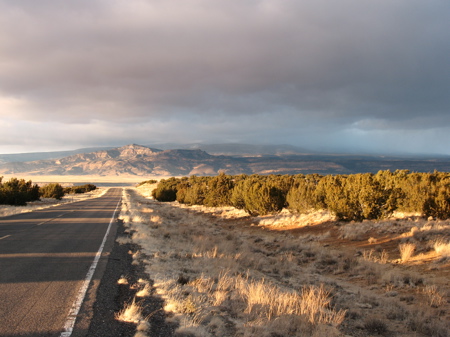
Every year, the National Trust for Historic Preservation publishes a list of “America’s 11 Most Endangered Historic Places”. A “Place” is broadly defined enough to include whole communities and towns, districts, individual buildings, and nature sites. Places of all ages and styles are given consideration. Making it on the list raises awareness of a place’s plight, with the hope that activism will lead to a happy ending, though it often doesn’t.
 This year’s list includes Frank Lloyd Wright’s century old Unity Temple in Oak Park, IL (rendering pictured above). The building is endangered due to massive deterioration of the structure and interiors. Besides being the only surviving example of public architecture from Wright’s Prairie period, it is also recognized as the first building in the world built from steel reinforced poured in place concrete – a pioneering technique that is now de rigueur in modern architecture. Unfortunately, the experimental construction did not include the use of expansion joints to relieve pressure from movement in the building shell. Hence, the intense cracking and crumbling the building is now a victim of.
This year’s list includes Frank Lloyd Wright’s century old Unity Temple in Oak Park, IL (rendering pictured above). The building is endangered due to massive deterioration of the structure and interiors. Besides being the only surviving example of public architecture from Wright’s Prairie period, it is also recognized as the first building in the world built from steel reinforced poured in place concrete – a pioneering technique that is now de rigueur in modern architecture. Unfortunately, the experimental construction did not include the use of expansion joints to relieve pressure from movement in the building shell. Hence, the intense cracking and crumbling the building is now a victim of.

Other places on the list include the 12,000’ tall Mount Taylor in New Mexico, which sits on the largest uranium deposit in the country.

Plus, Miami Marine Stadium that was built in 1963 using an innovative folded plate concrete structure. The stadium was damaged by Hurricane Andrew in 1998 and has sat unrepaired ever since.
The current complete list can be found at the NTHP’s website, or concisely at the AIA.
Do you live near one of these or past places from the list and want to share your thoughts? Is there value in the preservation of historic places, and how do we reconcile it with the drive to move forward?


I really believe renovation and preservation is a vital part of our society, because of the vast difference between learning from something in a book as compared to seeing it in person. One example of this is FLW’s Fallingwater, which is now maintained by the Western Pennsylvania Conservancy. Without this organization’s efforts, Fallingwater would probably not exist today, and if it did, would not be in the same condition.
Also, just a year ago, New Jersey governor Jon Corzine decided to cut money out of New Jersey’s state parks’ funding, leading to the possible closing of nine NJ parks!
The list of nine state parks that would close:
— Monmouth Battlefield State Park, 2,928 acres, Monmouth County. Visitor center, restrooms, closed.
— Stephens State Park, 805 acres, Warren County. Camping area closed.
— High Point State Park, 15,827 acres, Sussex County. Swimming, camping, interpretive center, office, closed. Trail access limited.
— Brendan T. Byrne State Forest (formerly Lebanon State Forest), 36,647 acres, Burlington County. Camping, group picnic area, Indian King Tavern, office, closed. Trail access limited.
— Round Valley Recreation Area, 3,684 acres, Hunterdon County. Swimming, camping, Wallace House, office, closed.
— Parvin State Park, 1,952 acres, Salem County. Swimming, camping, interpretive center, office, closed.
— Jenny Jump State Forest, 4,288 acres, Warren County. Camping and office, closed. Trail access limited.
— Worthington State Forest, 6,584 acres, Warren County. Camping and office, closed. Trail access limited.
— Fort Mott State Park, 104 acres, Salem County. Hancock House, historic sites, office, closed. Access to ferry service, open.
The list of three New Jersey state parks that would partially close under the proposed budget:
— Ringwood State Park, 4,044 acres, Bergen and Passaic counties. Shepherd Lake swimming area closed; Ringwood Manor, reduced hours. State Botanical Gardens and Skylands Manor, open.
— D&R Canal State Park, 5,379 acres, central New Jersey. Bulls Island Recreation Area closed to campers. Rockingham Historic Site and towpath, open.
— Washington Crossing State Park, 3,126 acres, Mercer and Hunterdon counties. Significantly reduced hours at Clark House, Johnson Ferry House and the museum.
Winter hours at all remaining parks would be reduced. All but Liberty and Island Beach state parks would be closed Mondays and Tuesdays from Nov. 1 through March 31.
( For the entire article, read here – http://www.nj.com/news/index.ssf/2008/04/nine_state_parks_may_close_und.html )
Not only would this mess up plans for camping, day trips, hiking (including the Appalachian Trail!), bird-watching, picnics, and countless other outdoor activities, but it would cut off important historical sites and prevent future generations from enjoying the places we love!
My dad used to always travel to High Point State Park (which is about 20 min from my home now), with his family as a child, and many of the things he was able to see are already gone, such as a mansion that was destroyed because there was no funding available to renovate it, leaving all of the artwork and artifacts within to be left in a warehouse. Luckily, the High Point Monument, an obelisk much like the Washington Monument in DC, has been restored numerous times and has withstood the high winds in the highest elevation of New Jersey.
I firmly believe that preservation is important, not only for learning, but also for maintaining the great icons of architecture, the environment, the country, the world, etc. Being able to see what people saw hundreds of years ago is such a tremendous experience, and it’s and ideal that should not be taken for granted or lost.